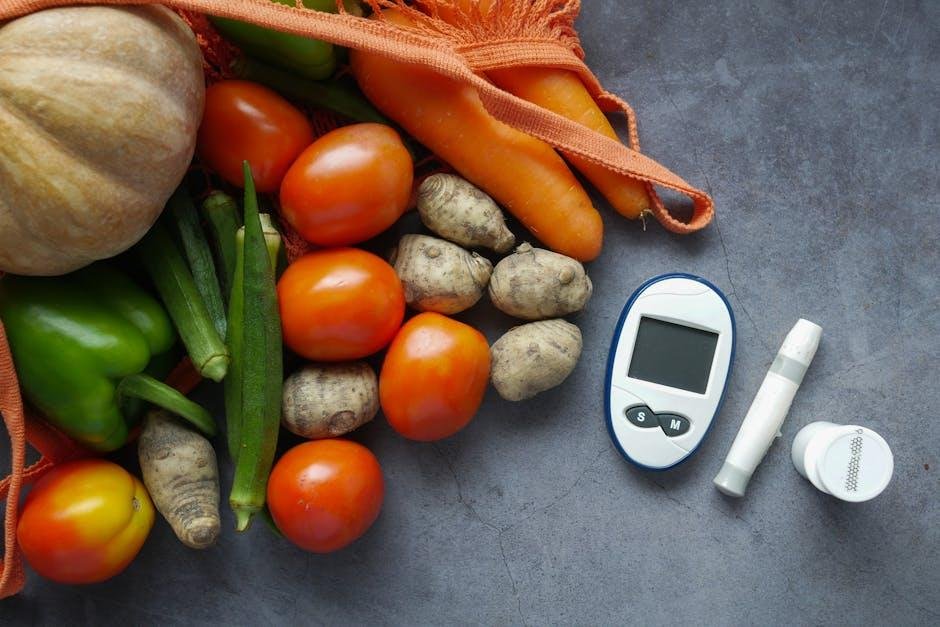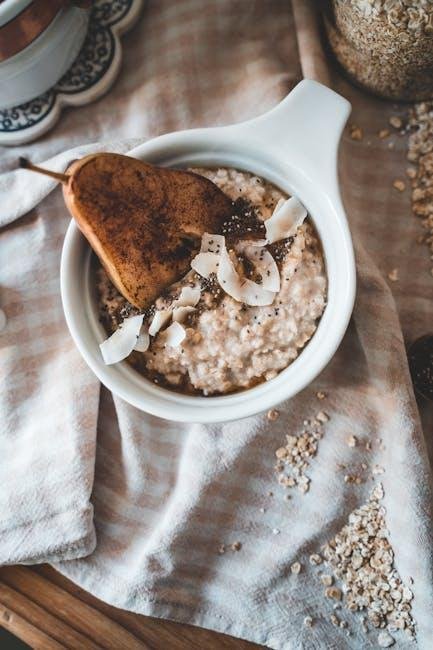In a world where flavors and nutrition often feel at odds, crafting a meal plan that delights the palate while supporting health can seem like an art form—especially for those managing diabetes. Balancing blood sugar levels requires more than just willpower; it calls for thoughtful choices that nourish the body without sacrificing enjoyment. This article explores diabetes-friendly meal plans designed to empower individuals to embrace food as both medicine and pleasure. Through mindful combinations of ingredients, these plans offer a roadmap to creating satisfying meals that honor the delicate dance between taste and wellness.
Table of Contents
- Understanding Diabetes and Nutritional Needs
- Balancing Carbohydrates for Stable Blood Sugar
- Incorporating Fiber-Rich Foods for Better Control
- Smart Protein Choices to Enhance Energy Levels
- Healthy Fats That Support Heart Health
- Sample Meal Ideas for Breakfast, Lunch, and Dinner
- Q&A
- Insights and Conclusions

Understanding Diabetes and Nutritional Needs
Managing blood sugar levels effectively hinges on understanding how different foods interact within the body. Carbohydrates, proteins, and fats each play distinct roles in impacting glucose levels, energy, and overall health. Balancing these macronutrients is vital for those with diabetes to avoid sudden spikes or drops in blood sugar. Moreover, incorporating fiber-rich foods like vegetables, legumes, and whole grains can slow glucose absorption, helping maintain steadier levels throughout the day.
Beyond macronutrients, micronutrients and hydration also significantly influence diabetic care. Key vitamins and minerals support insulin function and cellular health, so a nutrient-dense diet is essential. Below is a simple guide highlighting food categories ideal for diabetes management:
- Non-starchy vegetables: Spinach, broccoli, peppers
- Lean proteins: Fish, chicken, plant-based options
- Healthy fats: Olive oil, nuts, avocado
- Whole grains: Quinoa, barley, oats
| Food Group | Recommended Choices | Impact on Blood Sugar |
|---|---|---|
| Non-Starchy Vegetables | Spinach, Kale, Cauliflower | Minimal impact, high fiber |
| Lean Protein | Eggs, Turkey, Tofu | Supports muscle, stabilizes glucose |
| Healthy Fats | Avocados, Walnuts, Olive Oil | Promotes satiety, lowers glucose spikes |
| Whole Grains | Brown Rice, Quinoa, Barley | Slow digestion, sustained energy |

Balancing Carbohydrates for Stable Blood Sugar
Managing the types and amounts of carbohydrates you consume plays a crucial role in maintaining steady blood sugar levels. Instead of eliminating carbohydrates entirely, focus on integrating complex carbs such as whole grains, legumes, and vegetables, which digest slowly and provide a gradual energy release. Pairing carbohydrates with protein and healthy fats further moderates blood sugar spikes, creating a harmonious balance that supports long-term health.
Consider incorporating these smart balancing strategies into your meals:
- Choose fiber-rich carbs like quinoa, oats, and leafy greens to slow sugar absorption
- Practice portion control by measuring carb servings to avoid sudden blood sugar surges
- Combine with protein and fats such as nuts, seeds, or lean meats to stabilize glucose levels
- Limit refined sugars and processed snacks that cause rapid increases in blood sugar
| Carb Type | Best Paired With | Effect on Blood Sugar |
|---|---|---|
| Whole Grain Bread | Avocado & Turkey | Steady rise |
| White Rice | Broccoli & Tofu | Moderate spike |
| Brown Rice | Beans & Mixed Veggies | Slow absorption |
| Fruit | Greek Yogurt | Controlled glucose |

Incorporating Fiber-Rich Foods for Better Control
Fiber plays a crucial role in managing blood sugar levels by slowing digestion and promoting a gradual release of glucose into the bloodstream. Including fiber-rich foods like legumes, whole grains, vegetables, and fruits in your daily diet can significantly improve glycemic control. Not only does fiber help reduce blood sugar spikes, but it also supports digestive health and helps maintain a healthy weight, both of which are key factors in diabetes management.
To make fiber incorporation simpler, consider the following practical swaps and additions that can be seamlessly integrated into your meal plans:
- Replace white rice with quinoa or brown rice
- Snack on raw veggies with hummus instead of processed chips
- Add ground flaxseeds or chia seeds to yogurt and smoothies
- Use oats in baking or as a base for breakfast bowls
| Food | Fiber Content (per 100g) | Glycemic Impact |
|---|---|---|
| Chickpeas | 7.6g | Low |
| Broccoli | 2.6g | Low |
| Oats | 10.6g | Moderate |
| Apples (with skin) | 2.4g | Low |

Smart Protein Choices to Enhance Energy Levels
Incorporating the right proteins into your meals can be a game-changer for maintaining steady energy throughout the day, especially when managing diabetes. Opt for lean sources like skinless poultry, fish, and plant-based proteins such as lentils and chickpeas. These options provide essential amino acids without loading up on unhealthy fats that can spike blood sugar levels. Additionally, proteins play a crucial role in slowing down carbohydrate absorption, promoting balanced glucose responses that keep you energized without the dreaded crash.
To make smart protein choices easier, consider including foods that are rich in fiber and healthy fats alongside your protein intake. Here’s a quick guide to some standout options:
- Wild-caught salmon: Packed with omega-3 fatty acids for heart health.
- Quinoa: A complete plant protein with added fiber.
- Greek yogurt (unsweetened): A probiotic-rich choice that supports digestion.
- Egg whites: Low in calories but high in protein, perfect for snacks.
| Protein Source | Energy Level Impact | Diabetes-Friendly Benefit |
|---|---|---|
| Wild Salmon | High sustained energy | Improves insulin sensitivity |
| Lentils | Steady energy release | Rich in fiber, controls blood sugar |
| Greek Yogurt | Moderate energy boost | Supports gut health and glucose regulation |
| Egg Whites | Quick satiety, moderate energy | Low calorie, important for weight management |

Healthy Fats That Support Heart Health
Incorporating fats that nourish your heart while stabilizing blood sugar is a smart strategy for anyone managing diabetes. Not all fats are created equal; prioritizing sources rich in omega-3 and monounsaturated fats not only supports cardiovascular health but also helps reduce inflammation and improve insulin sensitivity. Including foods like avocados, olive oil, and fatty fish such as salmon and mackerel can be delicious and heart-friendly additions to your meals. These fats play a vital role in maintaining healthy cholesterol levels, promoting brain function, and providing essential fatty acids that the body can’t produce on its own.
Balancing healthy fats with other macronutrients helps create satisfying and diabetes-friendly meals. Here are some excellent choices to keep on your shopping list:
- Extra virgin olive oil – perfect for dressings and low-heat cooking
- Avocados – rich in fiber and potassium for heart support
- Chia seeds and flaxseeds – plant-based omega-3 powerhouses
- Nuts such as almonds and walnuts – convenient snack options packed with beneficial fats
- Fatty fish – a proven source of EPA and DHA omega-3s
| Healthy Fat Source | Key Benefit | Serving Idea |
|---|---|---|
| Olive Oil | Antioxidant-rich, lowers bad cholesterol | Drizzle over salads or steamed veggies |
| Avocado | High in fiber, controls blood sugar spikes | Add to smoothies or toast |
| Salmon | Boosts heart and brain health | Grilled or baked with herbs |

Sample Meal Ideas for Breakfast, Lunch, and Dinner
Kickstart your day with energizing options that balance blood sugar levels without compromising flavor. Consider incorporating a spinach and feta omelet paired with a slice of whole-grain toast, or a refreshing bowl of chia pudding topped with fresh berries and crushed nuts. These meals combine fiber, protein, and healthy fats—key ingredients for sustained energy throughout the morning. For those who prefer something lighter, opt for Greek yogurt mixed with cinnamon and sliced almonds, which offers probiotics alongside balanced nutrition.
Midday and evening meals can be just as exciting while adhering to diabetes-friendly guidelines. Serve a vibrant grilled chicken salad with mixed greens, avocado, cherry tomatoes, and a lemon vinaigrette for lunch, or enjoy a comforting plate of roasted salmon with quinoa and steamed broccoli for dinner. Below is a simple reference table with more options that cater to both convenience and health-conscious tastes:
| Meal | Protein | Healthy Sides | Flavor Booster |
|---|---|---|---|
| Breakfast | Scrambled eggs | Sautéed kale | Smoked paprika |
| Lunch | Turkey breast slices | Quinoa salad | Fresh herbs (basil, mint) |
| Dinner | Baked cod | Roasted asparagus | Garlic and lemon zest |
Q&A
Q&A: Navigating
Q1: What exactly is a diabetes-friendly meal plan?
A diabetes-friendly meal plan is a thoughtfully designed eating guide that aims to stabilize blood sugar levels while providing balanced nutrition. It focuses on controlling carbohydrate intake, prioritizing whole foods, and encouraging consistent meal timing to help manage diabetes effectively.
Q2: Why is carbohydrate management so important for people with diabetes?
Carbohydrates directly impact blood glucose levels because they break down into sugars during digestion. Managing carb intake prevents spikes and crashes in blood sugar, which is crucial for maintaining energy, preventing complications, and supporting overall health.
Q3: Are there specific foods that should be avoided in a diabetes-friendly diet?
Highly processed sugars, sugary beverages, and refined carbs like white bread or pastries often cause rapid blood sugar spikes and should be limited. Instead, whole grains, fiber-rich vegetables, and lean proteins are emphasized to create a steadier glucose response.
Q4: Can a diabetes-friendly meal plan be tasty and varied, or is it restrictive?
Absolutely, it can be both delicious and diverse! The key is creativity — exploring colorful veggies, herbs, spices, healthy fats, and lean proteins can make meals exciting while keeping blood sugar balanced. It’s about making smarter choices, not sacrificing flavor.
Q5: How often should someone with diabetes eat throughout the day?
Consistent meal timing usually helps maintain stable blood sugar. Many find that three balanced meals with healthy snacks in between work well, but individual needs vary. Working with a healthcare professional can tailor the schedule to personal preferences and medication routines.
Q6: Is counting calories or carbs necessary for everyone with diabetes?
Not necessarily. While some may benefit from tracking carbs to control blood sugar, others might focus more on food quality and portion size. The best approach depends on one’s type of diabetes, treatment plan, and lifestyle.
Q7: Can a diabetes-friendly meal plan help prevent diabetes complications?
Yes, maintaining balanced blood sugar through proper nutrition supports overall health and reduces risks for complications like heart disease, nerve damage, and kidney problems. It’s an invaluable tool alongside medication and physical activity.
Q8: How can someone start building their own diabetes-friendly meal plan?
Begin by including more non-starchy vegetables, lean proteins, healthy fats, and controlled portions of whole grains. Consulting a registered dietitian can provide personalized guidance. Experimenting with recipes and meal prepping can also ease the transition toward healthier habits.
Q9: Are there any popular diet approaches that align well with diabetes management?
Several diets, like the Mediterranean, DASH, and plant-based approaches, emphasize nutrient-dense foods and moderate carbohydrates and can be adapted to suit diabetes care. The most successful plan is one that fits your preferences and you can maintain long-term.
Q10: What role does physical activity play alongside a diabetes-friendly diet?
Exercise complements meal planning by improving insulin sensitivity and helping regulate blood sugar. Combining consistent physical activity with balanced nutrition creates a robust strategy for diabetes management and overall wellbeing.
Insights and Conclusions
Navigating the world of diabetes-friendly meal plans doesn’t have to feel like a puzzle. By embracing balanced, flavorful meals tailored to your unique needs, managing blood sugar becomes not just doable, but genuinely enjoyable. Remember, the journey to better health is a series of small, intentional choices—each plate a step toward greater well-being. So whether you’re a seasoned cook or just beginning to explore, let these meal plans inspire you to nourish your body with kindness and creativity every day.















Leave feedback about this